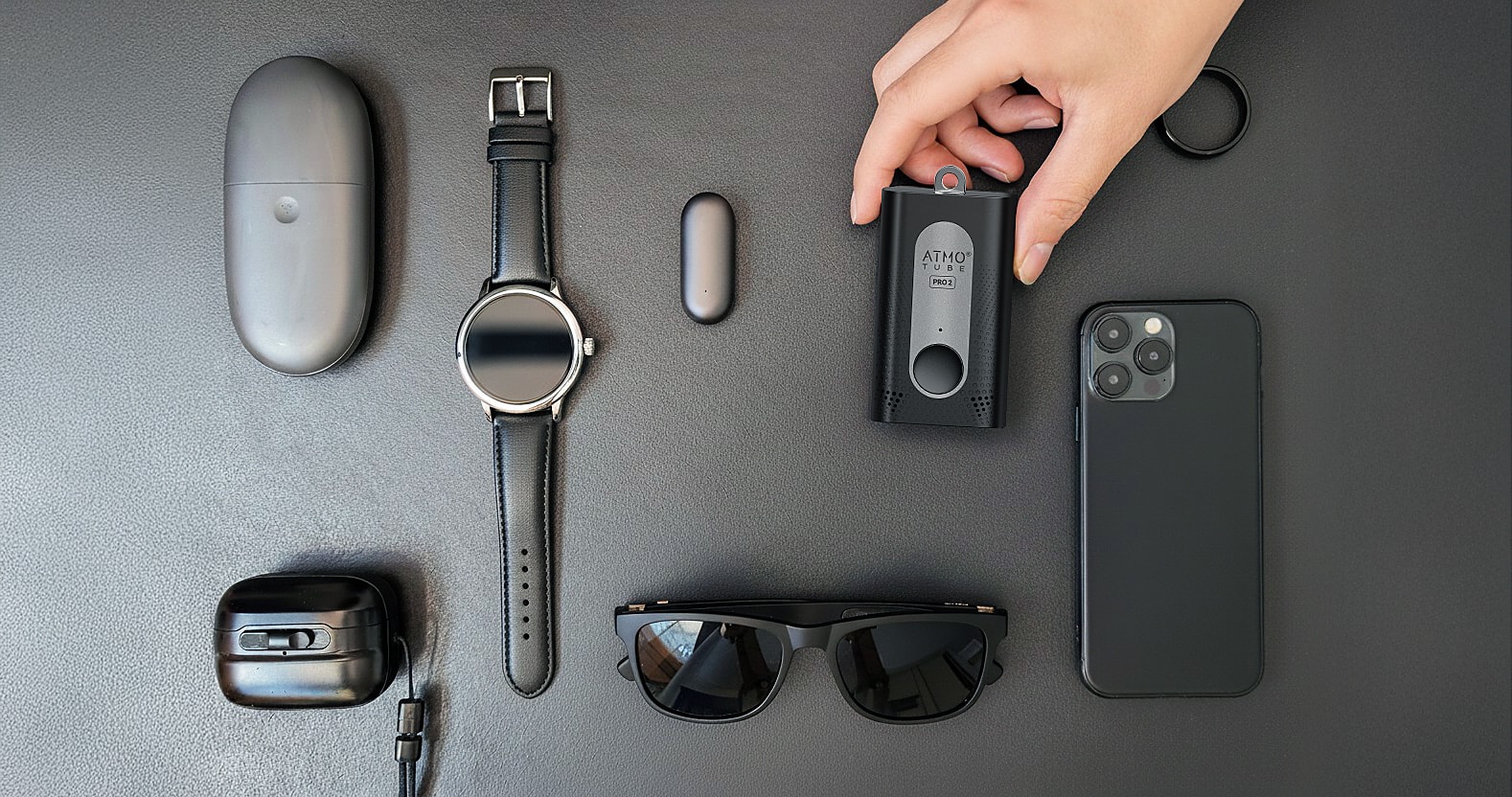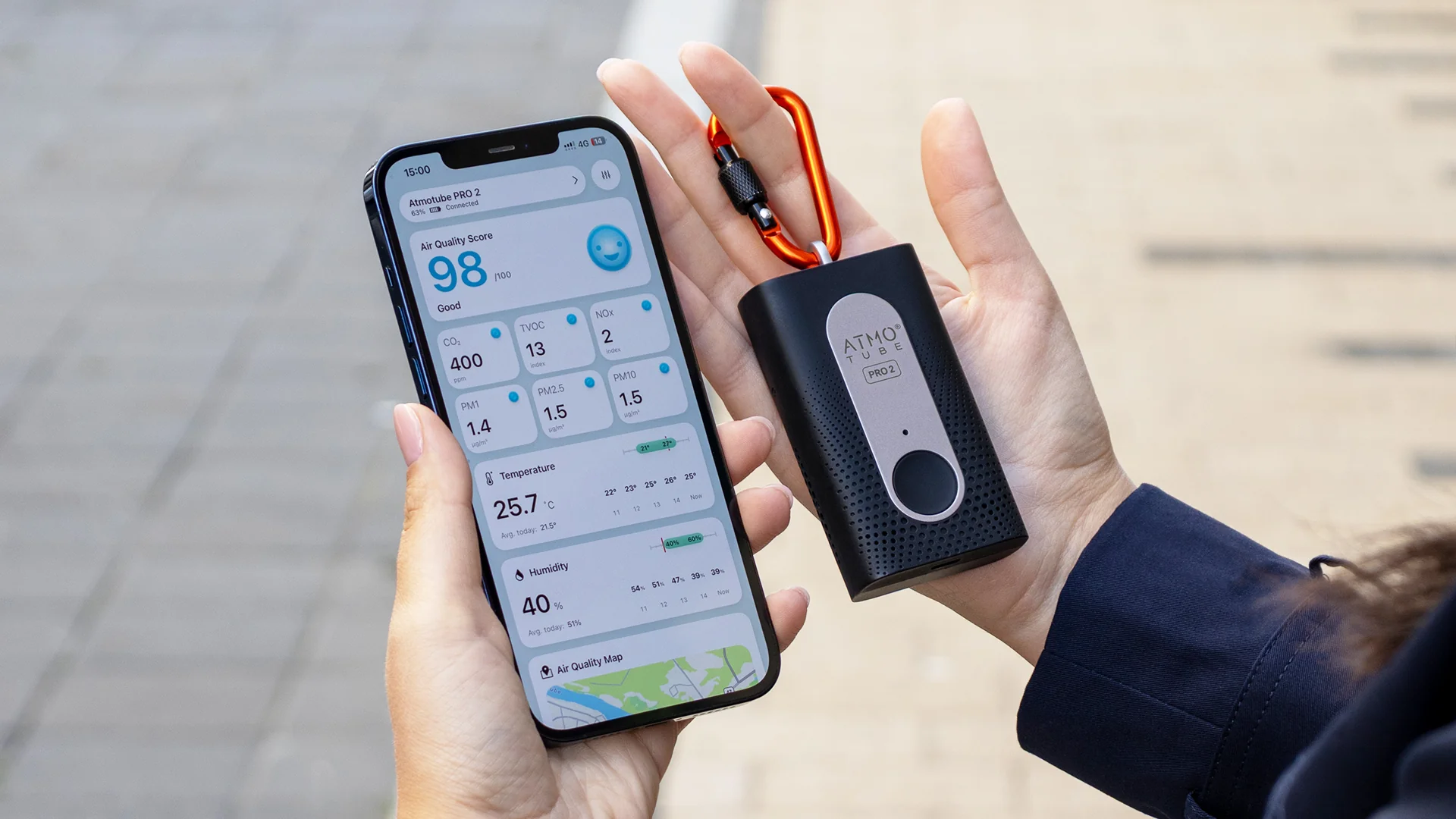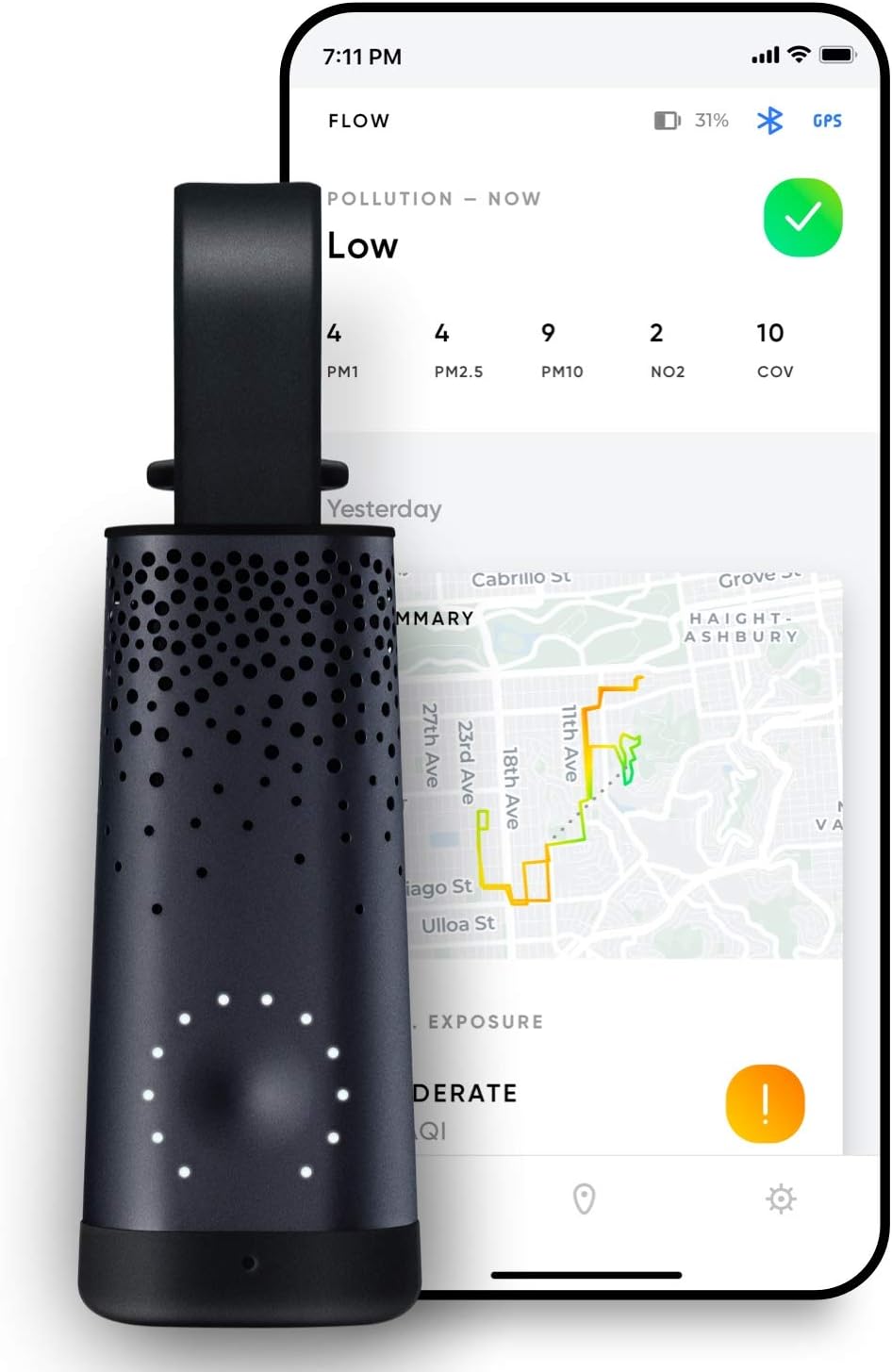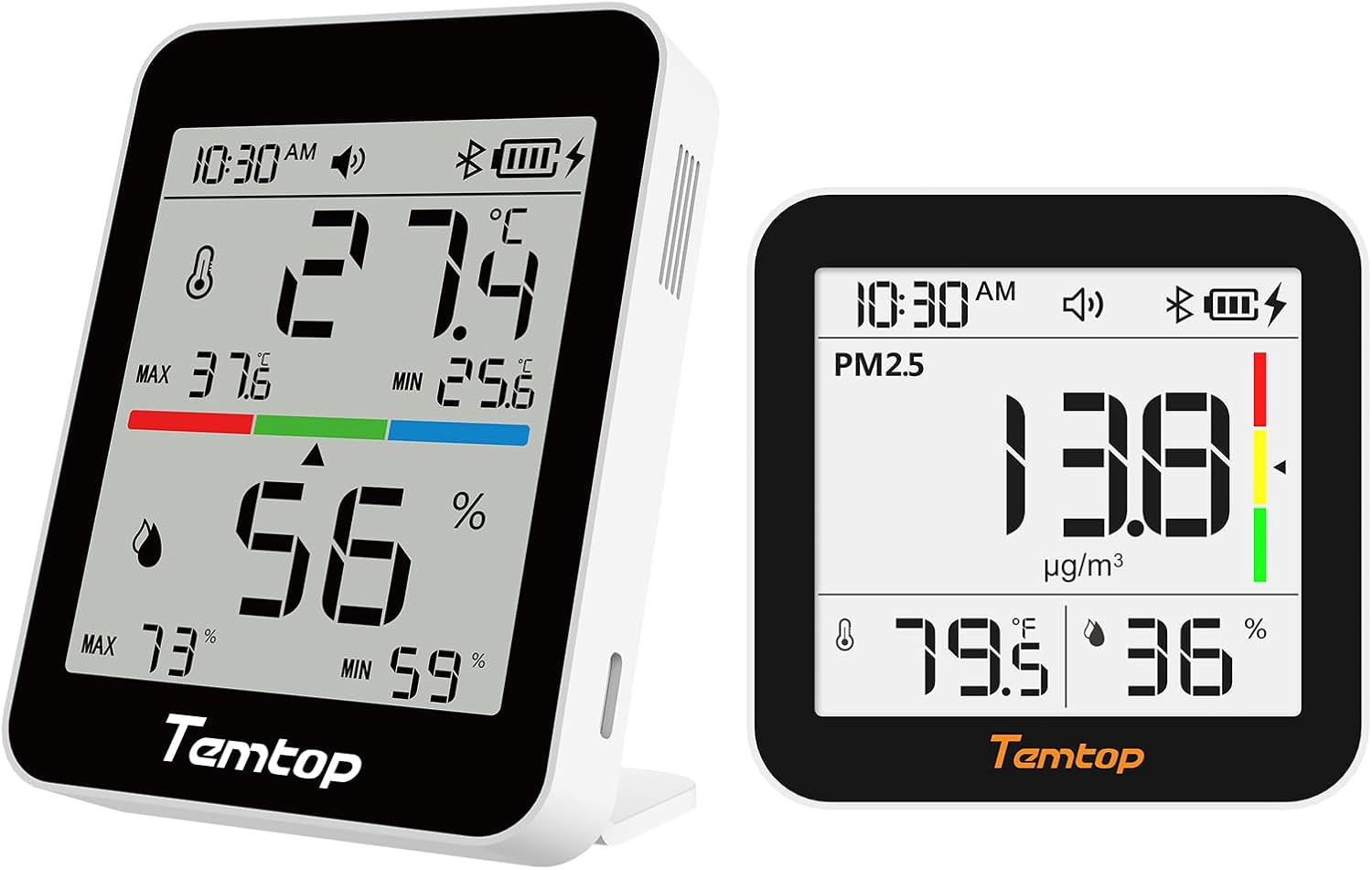
Updated on:
Air pollution is often invisible, but its health impacts are not. The World Health Organization estimates that exposure to polluted air contributes to around 7 million premature deaths every year worldwide.
Portable air quality monitors give you something powerful: real‑time information about the air you breathe at home, at work, and on the move. With a small device clipped to a backpack or sitting on your desk, you can see when fine particles, CO2 levels, or chemical vapors rise to levels that may affect your lungs, heart, or brain.
In this guide, we look at what a portable air quality monitor actually measures, how to choose the right one for your needs, and five of the best options on the market today—including Atmotube PRO 2—to help you breathe a little easier, wherever you are.
Scroll down to see our products
Why does a portable air quality monitor matter for your health?
Portable air quality monitors matter because they reveal unseen pollution that can quietly damage your lungs, heart, and nervous system over time.
Air pollution is one of the largest environmental health risks we face. WHO data indicate that the combined effects of ambient (outdoor) and household air pollution are linked to around 6.7 million premature deaths every year.
Fine particulate matter (PM2.5) can penetrate deep into the lungs and even enter the bloodstream, increasing the risk of heart attacks, strokes, aggravated asthma, and reduced lung function (EPA, 2025).
Because air quality can change street by street and hour by hour, especially during traffic peaks, wildfires, or temperature inversions, a portable sensor helps you understand your own personal exposure instead of relying only on distant monitoring stations. That insight lets you make practical choices: closing windows at the right time, changing your commuting route, or deciding when to run an air purifier or wear a mask.
What pollutants should a portable air quality monitor measure?
A good portable air quality monitor should focus on pollutants that are both common and strongly linked to health effects: fine particles, key gases, and chemical vapors.
At minimum, look for PM2.5 (fine particulate matter) because these tiny particles are considered among the most harmful pollutants for human health and are associated with cardiovascular and respiratory disease. Many monitors also track PM1 and PM10 to give a fuller picture of particle size ranges.
For indoor environments, CO2 is a valuable indicator of ventilation. Elevated CO2 by itself is usually not dangerous at levels seen in homes and schools, but it signals that exhaled air and other indoor pollutants are building up, which can contribute to headaches, fatigue, and reduced cognitive performance.
Volatile organic compounds (VOCs) are another important category. They come from paints, cleaning products, furniture, and some personal care items. Short‑term exposure can irritate eyes and airways, while long‑term exposure to certain VOCs is associated with increased cancer risk. Some advanced portable monitors also track nitrogen dioxide (NO2), ozone (O3), or radon for people who need deeper insight into their air.
Do you need indoor, outdoor, or wearable monitoring?
The best portable air quality monitor is the one that fits how you live: at home, on the road, or literally on your wrist or bag.
If your main concern is your home, office, or classroom, an indoor air quality monitor that sits on a shelf and tracks CO2, PM2.5, humidity, and sometimes radon will usually be enough. For people who spend a lot of time commuting, cycling in traffic, or traveling between cities, a truly portable or wearable monitor can reveal how exposure spikes along specific routes or in certain neighborhoods.
Some devices, such as Atmotube PRO 2, are designed to work both as an indoor air quality monitor and as a portable outdoor air quality monitor you can clip to a bag. Others are more focused on one use case, like indoor CO2 optimization or professional workplace dust monitoring.
How accurate are portable air quality monitors?
Portable air quality monitors are not laboratory instruments, but good models can provide useful, directionally accurate data for daily decisions.
Regulatory reference monitors used by government networks are large, carefully calibrated systems. By contrast, consumer devices rely on compact optical particle sensors and electrochemical gas sensors. Studies show that some low‑cost sensors can track trends in PM2.5 reasonably well, especially when properly calibrated, even if absolute values may differ from reference stations by 10–30% or more.
For everyday use, look for manufacturers that publish third‑party testing, provide clear specifications, and offer app‑based calibration or firmware updates. If you need data for regulatory reporting or workplace compliance, consider professional air quality monitors designed to meet specific occupational standards.
How did we choose the best portable air quality monitors?
We selected these five portable air quality monitors based on sensor coverage, portability, data quality, usability, and different use cases — from everyday home monitoring to professional exposure tracking.
Key criteria included:
- Pollutants measured (PM1 / PM2.5 / PM10, CO2, VOCs, NO2, radon, and more where available).
- True portability: battery life, size, and whether the device can realistically travel with you.
- Data access: mobile apps, cloud dashboards, historical graphs, and export options.
- Independent reviews and documentation, including third‑party evaluations where available.
- Price range and value, from budget‑friendly to professional‑grade equipment.
This list is not exhaustive, but it covers different needs: best indoor air quality monitor, best outdoor and wearable air quality monitor, best portable CO2 sensor, and a professional air quality monitor option for demanding environments.
What are the best portable air quality monitors in 2025?
Below are five stand‑out portable air quality monitors, including Atmotube PRO 2, with a focus on different use cases and budgets.
1. Atmotube PRO 2

Atmotube PRO 2 is a compact, wearable air quality tracker that measures a wide range of pollutants in real time, making it a strong all‑round choice for most people.
According to the manufacturer, Atmotube PRO 2 continuously monitors particulate matter (PM1, PM2.5, PM10), carbon dioxide (CO2), volatile organic compounds (VOCs), nitrogen oxides (NOx), temperature, humidity, and barometric pressure. These are precisely the parameters that influence how clean, fresh, or stuffy air feels — and how it may affect your respiratory and cardiovascular health.
The device is small enough to clip onto a bag or belt, but it can also sit on a desk as a portable indoor air quality monitor. Data is sent via Bluetooth to a mobile app, which provides an air quality score, pollutant breakdowns, and historical trends. Because it is designed for both indoor and outdoor use, it works well for commuters, parents, runners, or anyone who wants hyperlocal information as they move through a city.
Best for: people who want one versatile device for home, office, and travel.
2. Plume Labs Flow 2

Flow 2 by Plume Labs is a sleek, wearable personal air quality monitor designed especially for urban environments and commuting.
Independent reviews describe Flow 2 as a small handheld or wearable sensor that tracks particulate matter (PM1, PM2.5, PM10), nitrogen dioxide (NO2), and VOCs, with data synced to a smartphone app for mapping pollution hotspots along your routes. The manufacturer presents it as a next‑generation personal air quality monitor for indoor and outdoor use.
The companion app can visualize where you encounter the highest pollution during the day, which is valuable if you walk or cycle through busy streets and want to adjust your timing or route. While Flow 2 focuses more on particles and traffic‑related gases than on CO2, it can be a powerful tool for people whose main concern is outdoor and commuting exposure.
Best for: city commuters, cyclists, and walkers who want a truly wearable monitor.
3. Temtop M10 / M10+

Temtop’s M10 series offers compact, budget‑friendly portable air quality monitors that still cover several important indoor pollutants.
The Temtop M10 is advertised as a 4‑in‑1 monitor measuring PM2.5, formaldehyde (HCHO), total volatile organic compounds (TVOC), and an overall AQI score using laser particle and electrochemical sensors. Newer variants such as the M10+ add CO2, temperature, and humidity tracking for a more complete indoor air quality picture.
These devices are small enough to move from room to room and recharge via USB and can serve as a simple way to check whether activities like cooking, cleaning, or using new furniture are causing spikes in particles or chemical vapors. They will not match the precision of high‑end instruments, but they can be an accessible starting point for many households.
Best for: home users who want an affordable, easy‑to‑read indoor AQ monitor.
4. Airthings View Plus

Airthings View Plus is a smart indoor air quality monitor designed for continuous monitoring of multiple pollutants over months and years.
According to Airthings, View Plus includes sensors for radon, PM (including PM2.5), CO2, VOCs, temperature, humidity, and air pressure, all in a cable‑free, Wi‑Fi connected device with app and web dashboard support. Independent reviews highlight its ability to track long‑term trends and send alerts when parameters exceed user‑defined thresholds.
While View Plus is meant primarily for indoor use and is larger than pocket‑sized wearables, it is still portable in the sense that it runs on batteries and can be easily moved between rooms or even between homes and offices. It is especially useful for people worried about radon, stuffy meeting rooms, or children’s bedrooms.
Best for: homeowners, renters, and offices that need long‑term indoor monitoring.
5. Aranet4 Home

Aranet4 Home is a battery‑powered CO2 monitor that has become a reference tool for checking ventilation quality in homes, schools, restaurants, and shared spaces.
Aranet4 Home uses an NDIR CO2 sensor and also measures temperature, relative humidity, and atmospheric pressure in real time. The device features a low‑power e‑ink style display and can run for up to two years on batteries, with visual and audible alerts when CO2 levels become too high.
Because CO2 is a useful proxy for how much exhaled air has accumulated in a space, Aranet4 Home is particularly valuable for infection risk reduction, classroom ventilation checks, and identifying when it is time to open windows or adjust mechanical ventilation. Its small size and rugged design make it easy to carry between rooms or locations.
Best for: people who want to optimize indoor ventilation and reduce crowding‑related risks.
If you need a professional air quality monitor for occupational health, devices like the TSI SidePak AM520 personal aerosol monitor provide real‑time measurements of dust, fumes, mists, smoke, and other aerosols in a worker’s breathing zone using a laser photometer. These instruments are more expensive but are designed for industrial hygiene and compliance use.
How often should you check air quality at home and on the go?
For most people, checking air quality a few times a day and around key activities is enough to spot meaningful patterns.
Indoors, it is helpful to look at readings when you wake up, during cooking, and in the evening when more people are at home. If you use a CO2 or PM2.5 monitor continuously, pay attention to when levels tend to peak and how quickly they fall after you open windows or run an air purifier.
Outdoors, consider checking your portable air quality monitor before a run, school drop‑off, or commute, especially on days with wildfire smoke, smog alerts, or heavy traffic. Over time, you will build a mental map of when and where your personal exposure is highest.
Should you pair a portable air quality monitor with an air purifier?
Yes—a portable air quality monitor and an air purifier work best together, especially for indoor environments.
The monitor tells you when and how pollution changes; the purifier is one of the tools you can use to bring levels down. For example, if PM2.5 spikes every evening when cooking, a monitor can confirm whether your range hood and purifier are actually reducing particles quickly enough.
A monitor can also prevent over‑reliance on hardware: if CO2 or PM2.5 stays high even with a purifier running, it is a sign you may need better ventilation, behavior changes, or source control (like switching to cleaner heating or cooking methods).
How do you interpret the Air Quality Index (AQI)?
The Air Quality Index (AQI) is a color‑coded scale that translates pollution levels into simple health guidance, usually from 0 (good) to 500 (hazardous).
In the United States, the AQI is based on major pollutants regulated under the Clean Air Act: ground‑level ozone, particle pollution (PM2.5 and PM10), carbon monoxide, sulfur dioxide, and nitrogen dioxide. A daily index value is calculated for each pollutant, and the highest of those values becomes the overall AQI.
Most countries use similar color bands: green for good, yellow for moderate, orange for unhealthy for sensitive groups, red for unhealthy, and purple or maroon for very unhealthy or hazardous. When the local AQI or your portable monitor shows elevated levels, it is wise to reduce intense outdoor exercise, close windows, and use filtration if available.
FAQ: portable air quality monitors
What pollutants should a portable air quality monitor measure?
Ideally, look for at least PM2.5 and, for indoor use, CO2 and VOCs. PM2.5 is strongly linked to heart and lung disease, while CO2 and VOCs tell you about ventilation and chemical exposures.
Do I need an indoor or outdoor portable air quality monitor?
If you spend most of your time at home or in an office, a primarily indoor monitor with CO2, PM2.5, humidity, and temperature is a good start. If you commute, cycle, or travel often, a wearable or clip‑on device like Atmotube PRO 2 can show you outdoor hotspots on the move.
How often should I check air quality at home?
You do not need to stare at the screen all day. Instead, check at a few key moments—after cooking, when many people are in a room, or during smog or wildfire events. Continuous logging in the app lets you review patterns weekly rather than obsessing over every number.
Are smart air quality monitors worth it?
For most households, yes. Smart monitors with apps and Wi‑Fi can send alerts, show long‑term trends, and integrate with smart home systems so that purifiers or ventilation can respond automatically to poor air quality.
Do air quality monitors help with allergies or asthma?
They do not treat symptoms, but they can help identify triggers. For example, if PM2.5 or dust levels spike when you vacuum or open certain windows, you can adjust routines or use better filtration to reduce flare‑ups (EPA health effects of PM).
What accuracy level is considered good for a portable monitor?
Consumer‑grade monitors rarely match regulatory stations, but a well‑designed sensor that tracks trends reliably and stays within roughly ±20–30% of reference values for PM2.5 is often sufficient for personal decision‑making, according to evaluations of low‑cost sensors.
Can portable air quality monitors detect mold or VOCs?
Most cannot detect mold directly, but they can detect particles and VOCs associated with damp or mold‑prone environments. If your monitor shows persistent high humidity, elevated PM2.5, or VOCs in certain rooms, it is a signal to investigate moisture, leaks, or materials more closely.
Should I pair a portable air quality monitor with an air purifier?
Yes. The monitor tells you when the problem exists; the purifier and ventilation are part of the solution. Using both together allows you to verify that your purifier is sized correctly and actually reduces PM2.5 or smoke during high‑pollution events.
How do I interpret the AQI readings from my monitor or app?
Most apps map AQI into color bands from good to hazardous. Treating green as a sign it is safe to open windows and exercise, while orange, red, or worse suggests you should limit outdoor activity and use filtration if possible.
What is the best portable air quality monitor for travel?
For frequent travelers, compact devices such as Atmotube PRO 2 or small CO2 monitors like Aranet4 Home are popular because they are battery‑powered, fit in hand luggage, and can quickly reveal when hotel rooms, trains, or coworking spaces have poor air quality.
What is the next best step to improve your air quality?
A portable air quality monitor is not just a gadget; it is a feedback tool that connects your everyday choices with what you breathe.
Start by clarifying your main concern: indoor CO2 and stuffiness, city pollution on your commute, smoke and PM2.5 from wildfires, or professional dust exposure at work. Then choose a monitor that matches those needs—whether it is a versatile all‑rounder like Atmotube PRO 2, a smart indoor monitor such as Airthings View Plus, a budget Temtop M10, or a focused CO2 meter like Aranet4 Home.
Once you have data, experiment gently: open windows at different times, upgrade filters, move your workout, or adjust routes. The goal is not to chase perfect numbers but to steadily reduce your cumulative exposure over months and years, protecting your lungs, heart, and mind.
